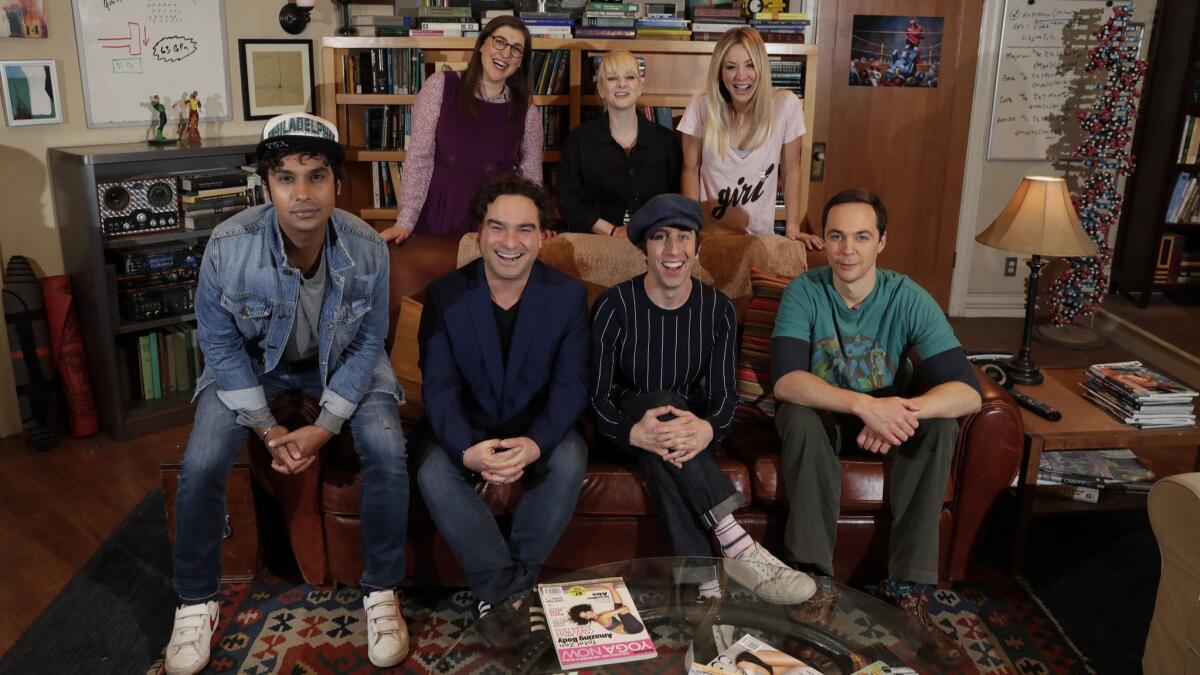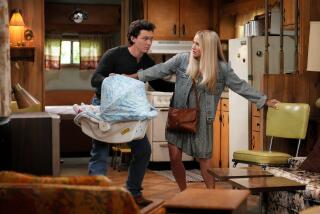What the remarkable run of ‚ÄėBig Bang Theory‚Äô means for Hollywood ‚ÄĒ and the show‚Äôs cast and crew

There‚Äôs the Big Bang Theory in science that explains how the universe began from a staggeringly hot, dense point roughly 13.7 billion years ago. But millions are more familiar with the other ‚ÄúBig Bang Theory‚ÄĚ‚ÄĒthe one that‚Äôs been on CBS for 11 years. And in the cosmos of modern-day television, it stands out like a shining star.
True, this multi-camera series is not the most buzzed-about comedy on the small screen and its broad, safe humor doesn‚Äôt exactly make it a sparkplug in the critical think-piece culture. And, yes, its awards success may lag far behind other comedies such as ‚ÄúModern Family‚ÄĚ or ‚ÄúVeep.‚ÄĚ
But against all odds, ‚ÄúThe Big Bang Theory‚ÄĚ has established itself as one of the pillars of the prime-time scene. It‚Äôs one of CBS‚Äô most reliable hits ‚ÄĒ the Thursday show is currently averaging 14 million total viewers (a number that rises to nearly 19 million when delayed viewing over a week is factored in), making it a force on one of television‚Äôs most popular nights. It‚Äôs launched a successful spinoff, made millionaires out of its previously little-known cast, employed hundreds of actors and crew members and served as a potent springboard for other new CBS comedies.
‚ÄúWe‚Äôve made more than 250 episodes,‚ÄĚ said veteran TV producer Chuck Lorre, who co-created the show with Bill Prady. ‚ÄúWe didn‚Äôt expect this, you know? We just wanted to make a show about extraordinary minds.‚ÄĚ
It’s the kind of long-running mainstream broadcast show that pours hundreds of millions of dollars into the local economy. The show’s steadfast heights are a rare achievement at a time of declining ratings and this gluttonous age of TV that, quite frankly, could benefit from a scientific formula to help viewers get a handle on all the TV shows vying for their attention. It remains one of the top 10 most watched shows in the country, with far more viewers than even the most popular streaming and cable series.
And it has accomplished this largely without resorting to stunts, gimmicks, or flashy guest stars while continuing to mine gold out of its premise and no-frills formula of young genius grappling with the fast-evolving real world. A fact that is not lost on executive producer Steven Molaro, who served as a longtime showrunner on the series until last year when he left to shepherd the comedy‚Äôs prequel spinoff, ‚ÄúYoung Sheldon.‚ÄĚ
‚ÄúThere‚Äôs so many TV shows out there ‚ÄĒ so many,‚ÄĚ Molaro said. ‚ÄúI get it. It‚Äôs always exciting to be like, ‚ÄėOh, this is something new and buzzy that people are talking about, I wanna see that.‚Äô But that people still care enough about these characters after 11 years ‚ÄĒ they don‚Äôt care that it‚Äôs broad, they don‚Äôt care that it‚Äôs multi-camera, it‚Äôs so crazy and gratifying.‚ÄĚ
The show’s longevity has helped maintain the sitcom’s status as a valued property for CBS and Warner Bros. Television, which produces the series.
RELATED: ‚ÄėThe Big Bang Theory‚Äô is ending, but we shouldn‚Äôt let multi-cam sitcoms die. Here‚Äôs why
‚ÄúThe value is incalculable,‚ÄĚ said Kelly Kahl, the president of CBS Entertainment who had been the head of scheduling when ‚ÄúThe Big Bang Theory‚ÄĚ launched. ‚ÄúEvery scheduler, every network president, anybody who works at a network, you live for a show like this. The interesting thing to me is it‚Äôs as dominant as it‚Äôs ever been.‚ÄĚ
MORE: The stars of ‚ÄėThe Big Bang Theory‚Äô are overachievers in their extra curricular activities
In addition to contributing for years to CBS‚Äô standing as the most-watched network, the show‚Äôs enviable ratings have made it a key profit-maker for the broadcaster ‚ÄĒ the series alone brought in $125 million-$150 million in ad revenue per season for CBS. And its syndication revenue has reportedly generated more than $1 billion for Warner Bros. Television.
‚ÄúThe financial reward has been extraordinary,‚ÄĚ said Peter Roth, the president and chief content officer of Warner Bros.Television. ‚ÄúBut as importantly, it‚Äôs a defining series for our studio. We are only as good as the product we make, when you have a show that resonates globally as much as this series does, it‚Äôs a source of tremendous pride.‚ÄĚ
Quite the evolution when you consider the show, which launched in 2007 on the precipice of television’s modernization, ranked No. 68 in its first season.
Conceived by Prady and Lorre, who was riding high on the success of ‚ÄúTwo and a Half Men,‚ÄĚ ‚ÄúThe Big Bang Theory‚ÄĚ was inspired by the personalities Prady encountered during his pre-Hollywood career as a computer programmer.
The original pilot was developed for the 2006-07 television season and featured the characters Leonard and Sheldon ‚ÄĒ played by Johnny Galecki and Jim Parsons, respectively ‚ÄĒ who were socially challenged physicists working at Caltech. The original female lead was a street-smart character, Katie, played by Amanda Walsh.
When the pilot didn’t get picked up, Lorre and Prady retooled it. Katie became Penny, an across-the-hall neighbor who is a waitress with Hollywood ambitions (with a less-manipulative demeanor), played by Kaley Cuoco. And friends were added: aerospace engineer Howard Wolowitz, played by Simon Helberg, and astrophysicist Raj Koothrappali, played by Kunal Nayyar.
The overhaul got the pilot picked up. The show premiered in the fall of 2007, to so-so ratings. Its fate grew grim when just half of its initial 13-episode order aired before the 2007-08 Writers Guild strike halted production and brought Hollywood to a standstill.
‚ÄúMy biggest concern was, I was on a TV show and I had just bought a new car,‚ÄĚ Nayyar recalls. ‚ÄúI had bought an Audi and I was like, oh my God, I have to make the payments on my Audi. I called my dad and was like, Dad, I don‚Äôt know If I can afford this if we don‚Äôt come back to work.‚ÄĚ
Galecki, too, recalled the anxiety: ‚ÄúWe left the stage when that writers strike hit, very depressed. It felt like we hadn‚Äôt gotten a foothold. We didn‚Äôt think we had enough time for word of mouth to catch on.‚ÄĚ
But it did. Instead of becoming a casualty, ‚ÄúThe Big Bang Theory‚ÄĚ thrived, steadily building an audience who caught up on the reruns CBS ran during the strike ‚ÄĒ the luck of a pre-Netflix era.
‚ÄúAt some point you read the numbers and you can kind of read the audience‚Äôs passion,‚ÄĚ Kahl said. ‚ÄúThat‚Äôs something we saw over the strike, the repeats were doing almost as well as the originals. That‚Äôs something that, as a scheduler, tells you something‚Äôs happening and that people are discovering the show.‚ÄĚ
The show continued on an upward trajectory from there, eventually reaching a point where it was earning multiple season renewals. American viewers were fully geeking out over the series ‚ÄĒ undeterred by its smarty-pants leads and references to the Doppler effect and projectile motion.
‚ÄúIt just got bigger and bigger,‚ÄĚ Helberg said. ‚ÄúFor the first six or seven years, it was like every episode was bigger than the last.‚ÄĚ
Further proof of its power came in its fourth season when, after airing Monday nights its first three years, CBS made the bold decision to move the comedy to the competitive 8 p.m. slot on Thursdays ‚ÄĒ where the comedy proved itself as a mighty competitor to ‚ÄúAmerican Idol.‚ÄĚ Not long after, in 2011, the show entered syndication, with heavy repeats on local broadcast stations and cable‚Äôs TBS fueling the fandom by introducing the series to new viewers.
All this from a multi-camera sitcom, a format whose obituary has been written many times, on a broadcast network.
Every scheduler, every network president, anybody who works at a network, you live for a show like this.
— Kelly Kahl, president of CBS Entertainment
On a recent Tuesday on Stage 25 on the Warner Bros. lot in Burbank, taping of the show’s milestone 250th episode is underway. Lorre and Prady are in the wings observing as the 200-plus audience members, which includes Cuoco’s dad (a regular visitor each week), laugh it up while a back-and-forth unfolds in Sheldon and Amy’s apartment about the origins of the sandwich during the gang’s regular Friday night gathering for Chinese takeout. A simple windup, sure, but that’s part of the charm, the cast and producers say.
‚ÄúWe are a broadcast show and I think doing this show and seeing the response it‚Äôs gotten has brought meaning to that word for me in a way that I never understood before,‚ÄĚ said Parsons, the series‚Äô biggest breakout star. ‚ÄúThe goal here is to attract as broad an audience as possible and there‚Äôs a cynical way of looking at that, which is, ‚ÄėWell, of course you do, it‚Äôs a business model and you want the most money.‚Äô Well, sure, but I think the more pure way of looking at something like this is that as an artist, as a creator, as a performer, as an entertainer, it‚Äôs not an uncommon thing to want to entertain as many people as possible.‚ÄĚ
Though Parsons has become a four-time Emmy winner for his role as Sheldon, the sitcom hasn’t been much of an awards-show magnet.
‚ÄúI don‚Äôt think the show gets enough credit ‚ÄĒ and I mean that in the sense of the writers don‚Äôt,‚ÄĚ Cuoco said. ‚ÄúI don‚Äôt think people understand having to write something funny 24 weeks out of the year is so unbelievably difficult. It‚Äôs almost impossible to keep something this funny up for so long.‚ÄĚ
Keeping viewers engaged to the levels ‚ÄúThe Big Bang Theory‚ÄĚ commands over a long haul is no easy task. The producers behind ‚ÄúThe Big Bang Theory,‚ÄĚ admit it‚Äôs a challenge to come up with real, relatable and funny stories. But not impossible. Allowing for character development, which comes at molasses pace for this group of social misfits, and introducing new characters to expand the world has been key.
‚ÄúYou want these characters to grow and change,‚ÄĚ said Steve Holland, a longtime executive producer and writer on the series who, this year, became its showrunner. ‚ÄúBut you don‚Äôt want to lose who they are.‚ÄĚ
RELATED: ‚ÄėBig Bang Theory‚Äô showrunner Steve Holland on ending the series: ‚ÄėFinales are hard‚Äô
Two female characters were added as series regulars in the show‚Äôs fourth season. Microbiologist Bernadette Rostenkowski, played by Melissa Rauch, became a love interest for wannabe womanizer Howard ‚ÄĒ they eventually got married and, this season, are expecting another child. And neurobiologist Amy Farrah Fowler, played by Mayim Bialik, through her relationship with Sheldon, became an opportunity to explore two socially awkward people developing a relationship and learning to be vulnerable ‚ÄĒ they‚Äôve had sex and took things to the next level by moving in together.
Molaro pointed to the decision to have Sheldon and Amy move in together as a development that resulted in a lot of debate.
‚ÄúWe thought a lot about ‚ÄĒ is that a good idea? Is that a bad idea? If Sheldon is not in the apartment,‚ÄĚ Molaro said, ‚Äúdid we break the show? It‚Äôs a lot of those moments and trying to find what feels real and right.‚ÄĚ
Holland added: ‚ÄúAnd it opened up a whole new world of stories and growth for the characters.‚ÄĚ
‚ÄúIt‚Äôs such a simple thing,‚ÄĚ Molaro continued, ‚ÄúHe moves 50 feet away and it gave birth to 100 stories.‚ÄĚ
Now, this week‚Äôs season finale on Thursday will feature the wedding of Sheldon and Amy ‚ÄĒ in what would seem to be a logical winding down of the series.
So how much bang is left in the series ‚ÄĒ especially since, after so many years on the air, its production price tag has escalated with producer fees and cast salaries. (The five main actors who have been with the series since its beginnings ‚ÄĒ Parsons, Galecki, Cuoco, Nayyar and Helberg ‚ÄĒ make just under $1 million an episode.) The show has already been renewed for a 12th season, but CBS and Warner Bros. Television have not yet announced plans to keep the show going beyond that.
‚ÄúObviously it will be dependent on the actors, the network‚Äôs need for it,‚ÄĚ Roth said. ‚ÄúI believe that everyone will be happy to have it continue as long as possible, but I think the actors will have to determine whether or not they want to continue.‚ÄĚ
In an industry where sustainability is the the hardest act to pull off, the sitcom‚Äôs longevity ‚ÄĒ as Nayyar puts it, ‚ÄúKids who were born 11 years ago are now watching the show‚ÄĚ ‚ÄĒ has made it a dependable employer. The series has a crew of roughly 150 on set‚ÄĒbut scores more work on the total production. (In 2016, according to FilmLA, there were about 150,000 direct jobs in film and television in Los Angeles County, largely driven by television. Those jobs totaled about $14 billion in wages in the county).
Mark Cendrowski, who directs most of the episodes of the sitcom, says finding stability in the unpredictable entertainment industry has been a windfall.
‚ÄúI‚Äôve been on shows throughout my career that get canceled the week before Christmas,‚ÄĚ Cendrowski said. ‚ÄúAnd I‚Äôve been out of work at times waiting because when a show gets canceled, other shows have already been staffed and you have to wait until something else comes along. That‚Äôs an anxiety-filled time. But here, we don‚Äôt have that. We know we‚Äôre coming back. And it makes life easier.‚ÄĚ
With likely more seasons behind it than ahead, though, it’s only natural to think of the looming end.
‚ÄúI look at the end of the show much like I think a devout Christian looks at death ‚ÄĒ not afraid but hopeful to see the thing that they believe in,‚ÄĚ Parsons said. ‚ÄúI know whenever the day comes I will be very emotional about it. It will be the natural death of something wonderful. Even though it‚Äôs not a tragedy, it‚Äôs one of those things where you‚Äôre still going to be, I would think, very moved to see the end of an era of your own life.‚ÄĚ
Twitter: @villarrealy
More to Read
The complete guide to home viewing
Get Screen Gab for everything about the TV shows and streaming movies everyone’s talking about.
You may occasionally receive promotional content from the Los Angeles Times.







